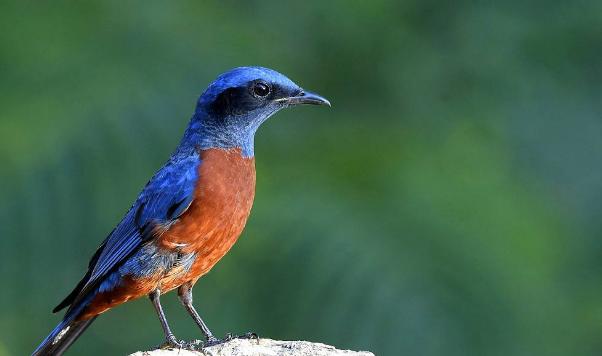Chestnut-bellied is the Latin scientific name monticola rufiventris large (24 cm) and male heterophotic is a partridge. During the breeding season, males have black face spots. The upper body is blue , and the tail , throat and lower body remainder are brightly maroon. It is distinguished from the red-bellied blue-bellied subspecies in that it has a black mask and a glossy blue forehead. However, the head is shaped like a bird and the neck and shoulders are less shiny blue. The female is brown with nearly black scallop-shaped markings on the upper body and dark brown and yellow scallop-shaped markings on the lower body. It differs from other females in that it has a whiteish skin-yellow crescent-shaped spot behind the dark ear feathers, with a broader yellow eye ring. Juveniles with ochre yellow spots and brown scallop-shaped markings,

China publishes mid-altitude zones in southern and southeastern Tibet, Sichuan, western Hubei, Fujian, Yunnan, Guizhou, Guangxi and Guangdong.
It mainly inhabits the montane evergreen broad-leaved forest, mixed coniferous and broad-leaved forest and coniferous forest at an altitude of 1500-3000 m, especially in the forest area along the steep cliffs and deep valleys of streams, which are more common in autumn and winter to the sparse forest and forest edge area below 2000 m to about 1000 m above sea level, and sometimes even enter the orchards near the village and the trees behind the houses in front of the house.
Mother bird
It is often done individually or in pairs, and occasionally small groups are integrated. Mostly rest on the top branches of the tree, the tail swings up and down, and occasionally the tail is fanned out. It feeds mainly on the ground and also preys on the air. During breeding, it is often a song that stands on the top of a tall tree for a long time. It feeds mainly on insects such as beetles, scarab beetles, locusts, grasshoppers, and caterpillars, but also eats snails, mollusks, lizards, frogs, aquatic insects and small fish. From May to July, the nest is in the cliff or rock crevice, the nest structure is rough, mainly composed of dry grass, branches and other materials, each nest lays 3-4 eggs, and the female is responsible for incubating the eggs